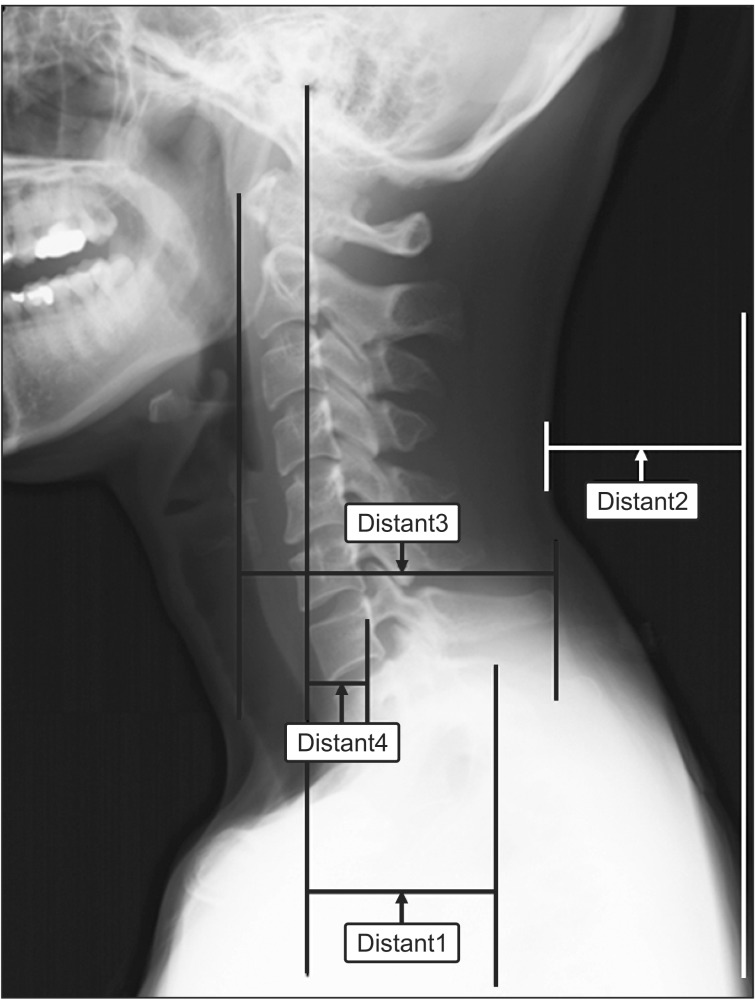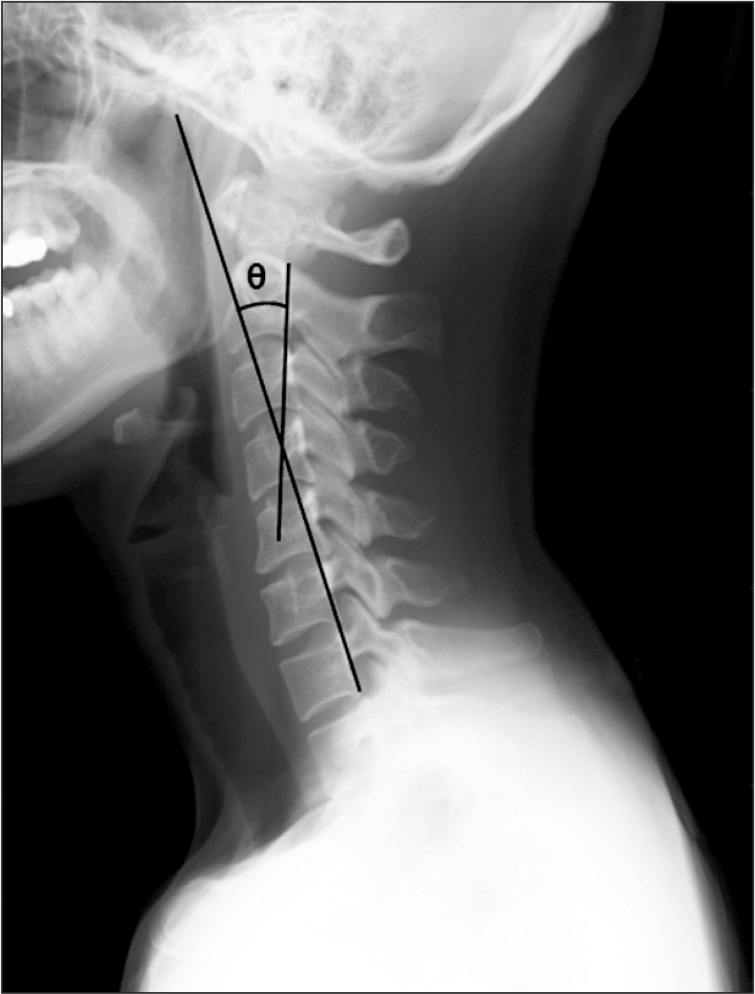Ann Rehabil Med.
2014 Dec;38(6):821-826. 10.5535/arm.2014.38.6.821.
Radiologic Assessment of Forward Head Posture and Its Relation to Myofascial Pain Syndrome
- Affiliations
-
- 1Department of Rehabilitation Medicine, Dankook University College of Medicine, Cheonan, Korea. schola21@gmail.com
- 2Department of Nanobiomedical Science & WCU Research Center, Dankook University, Cheonan, Korea.
- 3Institute of Tissue Regeneration Engineering, Dankook University, Cheonan, Korea.
- KMID: 2267093
- DOI: http://doi.org/10.5535/arm.2014.38.6.821
Abstract
OBJECTIVE
To assess head posture using cervical spine X-rays to find out whether forward head posture is related to myofascial pain syndrome (MPS) in neck and shoulder.
METHODS
Eighty-eight participants who were diagnosed with MPS in neck and shoulder were evaluated in this study. Four parameters (distance among head, cervical spines, and shoulder, and cervical angle) were measured from lateral view of cervical spine X-ray. The location and number of trigger points in the neck and shoulder and symptom duration were evaluated for each patient.
RESULTS
Both horizontal distances between C1 vertebral body and C7 spinous process and between the earhole and C7 vertebral body were negatively correlated with cervical angle reflecting cervical lordosis (p<0.05). Younger patients had significantly (p<0.05) less cervical angle with more forward head posture. There was no relationship between MPS (presence, location, and number of trigger points) and radiologic assessments (distance parameters and the cervical angle).
CONCLUSION
Forward head posture and reduced cervical lordosis were seen more in younger patients with spontaneous neck pain. However, these abnormalities did not correlate with the location or the number of MPS. Further studies are needed to delineate the mechanism of neck pain in patients with forward head posture.
MeSH Terms
Figure
Reference
-
1. Kang JH, Park RY, Lee SJ, Kim JY, Yoon SR, Jung KI. The effect of the forward head posture on postural balance in long time computer based worker. Ann Rehabil Med. 2012; 36:98–104. PMID: 22506241.
Article2. Chiou WK, Chou WY, Chen BH. Notebook computer use with different monitor tilt angle: effects on posture, muscle activity and discomfort of neck pain users. Work. 2012; 41(Suppl 1):2591–2595. PMID: 22317111.
Article3. Treaster D, Marras WS, Burr D, Sheedy JE, Hart D. Myofascial trigger point development from visual and postural stressors during computer work. J Electromyogr Kinesiol. 2006; 16:115–124. PMID: 16146699.
Article4. Cho WH, Lee WY, Choi HK. An investigation on the biomechanical effects of turtle neck syndrome through EMG analysis. In : Proceedings of the Korean Society of Precision Engineering Conference; 2008 Nov; p. 195–196.5. Yoo WG, Yi CH, Cho SH, Jeon HS, Cynn HS, Choi HS. Effects of the height of ball-backrest on head and shoulder posture and trunk muscle activity in VDT workers. Ind Health. 2008; 46:289–297. PMID: 18544890.
Article6. Mostamand J, Lotfi H, Safi N. Evaluating the head posture of dentists with no neck pain. J Bodyw Mov Ther. 2013; 17:430–433. PMID: 24138999.
Article7. Peolsson A, Marstein E, McNamara T, Nolan D, Sjaaberg E, Peolsson M, et al. Does posture of the cervical spine influence dorsal neck muscle activity when lifting? Man Ther. 2014; 19:32–36. PMID: 23880061.
Article8. Yoo WG. Effect of the neck retraction taping (NRT) on forward head posture and the upper trapezius muscle during computer work. J Phys Ther Sci. 2013; 25:581–582. PMID: 24259806.
Article9. Yip CH, Chiu TT, Poon AT. The relationship between head posture and severity and disability of patients with neck pain. Man Ther. 2008; 13:148–154. PMID: 17368075.
Article10. Diab AA, Moustafa IM. The efficacy of forward head correction on nerve root function and pain in cervical spondylotic radiculopathy: a randomized trial. Clin Rehabil. 2012; 26:351–361. PMID: 21937526.
Article11. Silva AG, Punt TD, Sharples P, Vilas-Boas JP, Johnson MI. Head posture and neck pain of chronic nontraumatic origin: a comparison between patients and pain-free persons. Arch Phys Med Rehabil. 2009; 90:669–674. PMID: 19345785.
Article12. Kim DQ, Cho SH, Han TR, Kwon HJ, Ha M, Paik NJ. The Effect of VDT work on work-related musculoskeletal disorder. Korean J Occup Environ Med. 1998; 10:524–533.
Article13. Fernandez-de-Las-Penas C, Cuadrado ML, Pareja JA. Myofascial trigger points, neck mobility, and forward head posture in episodic tension-type headache. Headache. 2007; 47:662–672. PMID: 17501847.
Article14. Gupta BD, Aggarwal S, Gupta B, Gupta M, Gupta N. Effect of deep cervical flexor training vs. conventional isometric training on forward head posture, pain, neck disability index in dentists suffering from chronic neck pain. J Clin Diagn Res. 2013; 7:2261–2264. PMID: 24298492.
Article15. Travell JG, Simons DG. Myofascial pain and dysfunction: the trigger point manual (Volume 1. The upper extremities). 1st ed. Philadelphia: Williams & Wilkins;1983. p. 18–19.16. Harrison DE, Harrison DD, Cailliet R, Troyanovich SJ, Janik TJ, Holland B. Cobb method or Harrison posterior tangent method: which to choose for lateral cervical radiographic analysis. Spine (Phila Pa 1976). 2000; 25:2072–2078. PMID: 10954638.17. Hsiao LP, Cho CY. The effect of aging on muscle activation and postural control pattern for young and older computer users. Appl Ergon. 2012; 43:926–932. PMID: 22280848.
Article18. Boyle JJ, Milne N, Singer KP. Influence of age on cervicothoracic spinal curvature: an ex vivo radiographic survey. Clin Biomech (Bristol, Avon). 2002; 17:361–367.
Article19. Shahidi B, Haight A, Maluf K. Differential effects of mental concentration and acute psychosocial stress on cervical muscle activity and posture. J Electromyogr Kinesiol. 2013; 23:1082–1089. PMID: 23800438.
Article20. Pearson AM, Ivancic PC, Ito S, Panjabi MM. Facet joint kinematics and injury mechanisms during simulated whiplash. Spine (Phila Pa 1976). 2004; 29:390–397. PMID: 15094535.
Article21. Inami S, Shiga T, Tsujino A, Yabuki T, Okado N, Ochiai N. Immunohistochemical demonstration of nerve fibers in the synovial fold of the human cervical facet joint. J Orthop Res. 2001; 19:593–596. PMID: 11518267.22. Lee KE, Winkelstein BA. Joint distraction magnitude is associated with different behavioral outcomes and substance P levels for cervical facet joint loading in the rat. J Pain. 2009; 10:436–445. PMID: 19327645.
Article23. Porterfield JA, DeRosa C. Mechanical neck pain: perspectives in functional anatomy. 1st ed. Philadelphia: Saunders;1995. p. 83–115.24. Dong L, Smith JR, Winkelstein BA. Ketorolac reduces spinal astrocytic activation and PAR1 expression associated with attenuation of pain after facet joint injury. J Neurotrauma. 2013; 30:818–825. PMID: 23126437.
Article25. Lee KE, Davis MB, Mejilla RM, Winkelstein BA. In vivo cervical facet capsule distraction: mechanical implications for whiplash and neck pain. Stapp Car Crash J. 2004; 48:373–395. PMID: 17230274.
- Full Text Links
- Actions
-
Cited
- CITED
-
- Close
- Share
- Similar articles
-
- Thoracic Kyphosis and Myofascial Pain Syndrome in Male Adolescents
- The Effect of Forward Head Posture and Tension Type Headache on Neck Movement: For Office Worker
- Comparison of the muscle activity in the normal and forward head postures based on the pressure level during cranio-cervical flexion exercises
- Botulinum Toxin-Type A in Cervical Myofascial Pain Syndrome: A report of 3 cases
- The Effect of Postural Correction and Visual Feedback on Muscle Activity and Head Position Change During Overhead Arm Lift Test in Subjects with Forward Head Posture



